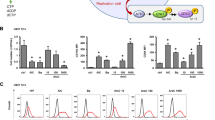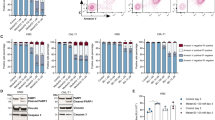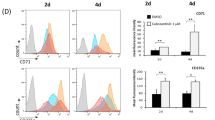Abstract
Cyclopentenyl cytosine (CPEC) is a carbocyclic cytidine analog inhibitor of CTP synthetase and experimental drug for combination chemotherapy. CPEC treatment (50 nM) depleted intracellular CTP and induced a specific S-phase arrest and erythroid differentiation of human erythroleukemia K562 cells. The equilibrative nucleoside transporters (ENT1, 2) facilitated uptake of CPEC into K562 cells as evidenced by both NBMPR and dipyridamole inhibition of CPEC-mediated CTP depletion and erythroid differentiation. Incubation with the pyridinylimidazole p38 MAPK inhibitors, SB203580 or SB220025, suppressed both the CPEC-induced cell cycle arrest and differentiation of K562 cells. SB203580 also prevented the cell cycle arrest and erythroid differentiation of K562 cells induced by Leflunomide (LEF), a non-nucleoside inhibitor of the de novo pyrimidine pathway, without affecting LEF-induced depletion of pyrimidine pools. Finally, selective knockdown of p38 MAPK by using Smart Pool™ siRNA to p38 MAPK significantly decreased the CPEC-induced differentiation of K562 cells. These results suggest that endogenous activity of p38 MAP kinases may be required for committing K562 cells to cell cycle arrest and erythroid differentiation under conditions of CTP depletion.
This is a preview of subscription content, access via your institution
Access options
Subscribe to this journal
Receive 12 print issues and online access
$259.00 per year
only $21.58 per issue
Buy this article
- Purchase on Springer Link
- Instant access to full article PDF
Prices may be subject to local taxes which are calculated during checkout






Similar content being viewed by others
References
Glazer RI, Knode MC, Lim MI, Marquez VE . Cyclopentenyl cytidine analogue. An inhibitor of cytidine triphosphate synthesis in human colon carcinoma cells. Biochem Pharmacol 1985; 34: 2535–2539.
Blaney SM, Grem JL, Balis FM, Cole DE, Adamson PC, Poplack DG . Mechanism of resistance to cyclopentenyl cytosine (CPE-C) in Molt-4 lymphoblasts. Biochem Pharmacol 1993; 45: 1493–1501.
Verschuur AC, Van Gennip AH, Leen R, Meinsma R, Voute PA, van Kuilenburg AB . In vitro inhibition of cytidine triphosphate synthetase activity by cyclopentenyl cytosine in paediatric acute lymphocytic leukaemia. Br J Haematol 2000; 110: 161–169.
Verschuur AC, Van Gennip AH, Leen R, Muller EJ, Elzinga L, Voute PA et al. Cyclopentenyl cytosine inhibits cytidine triphosphate synthetase in paediatric acute non-lymphocytic leukaemia: a promising target for chemotherapy. Eur J Cancer 2000; 36: 627–635.
Arita M, Adachi K, Sawai H, Ohno M . Enantioselective synthesis of new analogues of neplanocin A. Nucleic Acids Symp Ser 1983; 12: 25–28.
Lim MI, Moyer JD, Cysyk RI, Marquez VE . Cyclopentenyluridine and cyclopentenylcytidine analogues as inhibitors of uridine–cytidine kinase. J Med Chem 1984; 27: 1536–1538.
Gharehbaghi K, Zhen W, Fritzer-Szekeres M, Szekeres T, Jayaram HN . Studies on the antitumor activity and biochemical actions of cyclopentenyl cytosine against human colon carcinoma HT-29 in vitro and in vivo. Life Sci 1999; 64: 103–112.
Slingerland RJ, Van Gennip AH, Bodlaender JM, Voute PA, Van Kuilenburg AB . Cyclopentenyl cytosine and neuroblastoma SK-N-BE(2)-C cell line cells. Eur J Cancer 1995; 31A: 627–631.
Bierau J, van Gennip AH, Helleman J, van Kuilenburg AB . The cytostatic- and differentiation-inducing effects of cyclopentenyl cytosine on neuroblastoma cell lines. Biochem Pharmacol 2001; 62: 1099–1105.
Agbaria R, Kelley JA, Jackman J, Viola JJ, Ram Z, Oldfield E et al. Antiproliferative effects of cyclopentenyl cytosine (NSC 375575) in human glioblastoma cells. Oncol Res 1997; 9: 111–118.
Moyer JD, Malinowski NM, Treanor SP, Marquez VE . Antitumor activity and biochemical effects of cyclopentenyl cytosine in mice. Cancer Res 1986; 46: 3325–3329.
Gharehbaghi K, Szekeres T, Yalowitz JA, Fritzer-Szekeres M, Pommier YG, Jayaram HN . Sensitizing human colon carcinoma HT-29 cells to cisplatin by cyclopentenylcytosine, in vitro and in vivo. Life Sci 2000; 68: 1–11.
Verschuur AC, Brinkman J, Van Gennip AH, Leen R, Vet RJ, Evers LM et al. Cyclopentenyl cytosine induces apoptosis and increases cytarabine-induced apoptosis in a T-lymphoblastic leukemic cell-line. Leuk Res 2001; 25: 891–900.
Verschuur AC, Van Gennip AH, Leen R, Voute PA, Brinkman J, Van Kuilenburg AB . Cyclopentenyl cytosine increases the phosphorylation and incorporation into DNA of 1-beta-D-arabinofuranosyl cytosine in a human T-lymphoblastic cell line. Int J Cancer 2002; 98: 616–623.
Bierau J, Van Gennip AH, Leen R, Helleman J, Caron HN, Van Kuilenburg AB . Cyclopentenyl cytosine primes SK-N-BE(2)c neuroblastoma cells for cytarabine toxicity. Int J Cancer 2003; 103: 387–392.
Molnar A, Theodoras AM, Zon LI, Kyriakis JM . Cdc42Hs, but not Rac1, inhibits serum-stimulated cell cycle progression at G1/S through a mechanism requiring p38/RK. J Biol Chem 1997; 272: 13229–13235.
Park JI, Choi HS, Jeong JS, Han JY, Kim IH . Involvement of p38 kinase in hydroxyurea-induced differentiation of K562 cells. Cell Growth Differ 2001; 12: 481–486.
Le-Niculescu H, Bonfoco E, Kasuya Y, Claret FX, Green DR, Karin M . Withdrawal of survival factors results in activation of the JNK pathway in neuronal cells leading to Fas ligand induction and cell death. Mol Cell Biol 1999; 19: 751–763.
Johnson GL, Lapadat R . Mitogen-activated protein kinase pathways mediated by ERK, JNK, and p38 protein kinases. Science 2002; 298: 1911–1912.
Ono K, Han J . The p38 signal transduction pathway: activation and function. Cell Signal 2000; 12: 1–13.
Morooka T, Nishida E . Requirement of p38 mitogen-activated protein kinase for neuronal differentiation in PC12 cells. J Biol Chem 1998; 273: 24285–24288.
Hu Y, Chan E, Wang SX, Li B . Activation of p38 mitogen-activated protein kinase is required for osteoblast differentiation. Endocrinology 2003; 144: 2068–2074.
Engelman JA, Lisanti MP, Scherer PE . Specific inhibitors of p38 mitogen-activated protein kinase block 3T3-L1 adipogenesis. J Biol Chem 1998; 273: 32111–32120.
Zetser A, Gredinger E, Bengal E . p38 mitogen-activated protein kinase pathway promotes skeletal muscle differentiation. Participation of the Mef2c transcription factor. J Biol Chem 1999; 274: 5193–5200.
Witt O, Sand K, Pekrun A . Butyrate-induced erythroid differentiation of human K562 leukemia cells involves inhibition of ERK and activation of p38 MAP kinase pathways. Blood 2000; 95: 2391–2396.
Sawafuji K, Miyakawa Y, Kizaki M, Ikeda Y . Cyclosporin A induces erythroid differentiation of K562 cells through p38 MAPK and ERK pathways. Am J Hematol 2003; 72: 67–69.
Racke FK, Lewandowska K, Goueli S, Goldfarb AN . Sustained activation of the extracellular signal-regulated kinase/mitogen-activated protein kinase pathway is required for megakaryocytic differentiation of K562 cells. J Biol Chem 1997; 272: 23366–23370.
Baldwin SA, Mackey JR, Cass CE, Young JD . Nucleoside transporters: molecular biology and implications for therapeutic development. Mol Med Today 1999; 5: 216–224.
Clarke ML, Mackey JR, Baldwin SA, Young JD, Cass CE . The role of membrane transporters in cellular resistance to anticancer nucleoside drugs. Cancer Treat Res 2002; 112: 27–47.
Huang M, Kozlowski P, Collins M, Wang Y, Haystead TA, Graves LM . Caspase-dependent cleavage of carbamoyl phosphate synthetase II during apoptosis. Mol Pharmacol 2002; 61: 569–577.
Huang M, Wang Y, Collins M, Mitchell BS, Graves LM . A77 1726 induces differentiation of human myeloid leukemia K562 cells by depletion of intracellular CTP pools. Mol Pharmacol 2002; 62: 463–472.
Boleti H, Coe IR, Baldwin SA, Young JD, Cass CE . Molecular identification of the equilibrative NBMPR-sensitive (es) nucleoside transporter and demonstration of an equilibrative NBMPR-insensitive (ei) transport activity in human erythroleukemia (K562) cells. Neuropharmacology 1997; 36: 1167–1179.
Sinclair CJ, LaRiviere CG, Young JD, Cass CE, Baldwin SA, Parkinson FE . Purine uptake and release in rat C6 glioma cells: nucleoside transport and purine metabolism under ATP-depleting conditions. J Neurochem 2000; 75: 1528–1538.
Huang M, Wang Y, Cogut SB, Mitchell BS, Graves LM . Inhibition of nucleoside transport by protein kinase inhibitors. J Pharmacol Exp Ther 2003; 304: 753–760.
Huang M, Wang Y, Collins M, Gu JJ, Mitchell BS, Graves LM . Inhibition of nucleoside transport by p38 MAPK inhibitors. J Biol Chem 2002; 277: 28364–28367.
Zhang H, Cooney DA, Zhang MH, Ahluwalia G, Ford Jr H, Johns DG . Resistance to cyclopentenylcytosine in murine leukemia L1210 cells. Cancer Res 1993; 53: 5714–5720.
Pace BS, Qian XH, Sangerman J, Ofori-Acquah SF, Baliga BS, Han J et al. p38 MAP kinase activation mediates gamma-globin gene induction in erythroid progenitors. Exp Hematol 2003; 31: 1089–1096.
Pace BS, White GL, Dover GJ, Boosalis MS, Faller DV, Perrine SP . Short-chain fatty acid derivatives induce fetal globin expression and erythropoiesis in vivo. Blood 2002; 100: 4640–4648, Epub 2002 Aug 15.
Foley HA, Ofori-Acquah SF, Yoshimura A, Critz S, Baliga BS, Pace BS . Stat3 beta inhibits gamma-globin gene expression in erythroid cells. J Biol Chem 2002; 277: 16211–16219, Epub 2002 Feb 20.
Hietakangas V, Elo I, Rosenstrom H, Coffey ET, Kyriakis JM, Eriksson JE et al. Activation of the MKK4-JNK pathway during erythroid differentiation of K562 cells is inhibited by the heat shock factor 2-beta isoform. FEBS Lett 2001; 505: 168–172.
Voss J, Posern G, Hannemann JR, Wiedemann LM, Turhan AG, Poirel H et al. The leukaemic oncoproteins Bcr-Abl and Tel-Abl (ETV6/Abl) have altered substrate preferences and activate similar intracellular signalling pathways. Oncogene 2000; 19: 1684–1690.
Skorski T, Bellacosa A, Nieborowska-Skorska M, Majewski M, Martinez R, Choi JK et al. Transformation of hematopoietic cells by BCR/ABL requires activation of a PI-3k/Akt-dependent pathway. EMBO J 1997; 16: 6151–6161.
Acknowledgements
This work was supported by NIH grants GM 59767 and an AHA EI grant to LMG and a Leukemia Research Foundation grant to MH. Dr Beverly S Mitchell is acknowledged for valuable discussions and critical evaluation of the research.
Author information
Authors and Affiliations
Corresponding author
Additional information
b Supplementary Information
Supplementary Information accompanies the paper on Leukemia website (http://www.nature.com/leu).
Supplementary information
Rights and permissions
About this article
Cite this article
Huang, M., Wang, Y., Collins, M. et al. CPEC induces erythroid differentiation of human myeloid leukemia K562 cells through CTP depletion and p38 MAP kinase. Leukemia 18, 1857–1863 (2004). https://doi.org/10.1038/sj.leu.2403490
Received:
Accepted:
Published:
Issue Date:
DOI: https://doi.org/10.1038/sj.leu.2403490
Keywords
This article is cited by
-
A novel miR-200b-3p/p38IP pair regulates monocyte/macrophage differentiation
Cell Discovery (2016)
-
Induction of fetal hemoglobin and ABCB1 gene expression in 9-β-D-arabinofuranosylguanine-resistant MOLT-4 cells
Cancer Chemotherapy and Pharmacology (2011)
-
Basic fibroblast growth factor inhibits p38-mediated cell differentiation and growth inhibition by activin A but not by histone deacetylase inhibitors in CML cells
Annals of Hematology (2008)
-
A survey of the signaling pathways involved in megakaryocytic differentiation of the human K562 leukemia cell line by molecular and c-DNA array analysis
Oncogene (2006)



